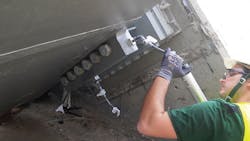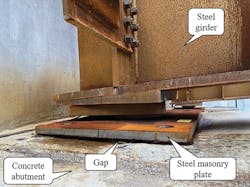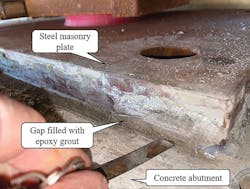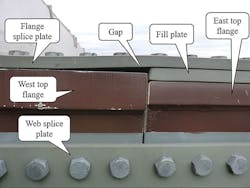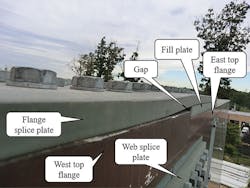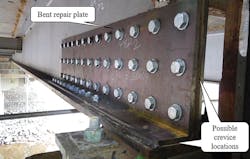By: Jason T. Provines
Corrosion is a common deterioration mode of steel bridges, leading to expensive maintenance operations.
Crevice corrosion is a prevalent form of corrosion on bridges. It is commonly initiated by a gap between two adjacent parts where water and salt—present through application of deicing salts or oceanic air—can collect. These gaps can be caused by improper fit-up (such as between steel plates on a bolted splice) or by misaligned parts (like unwanted gaps between a steel bearing and an uneven concrete abutment). Once water and salt infiltrate into the gap, accelerated corrosion can occur. This can eventually lead to pack rust, which causes unwanted stresses on the adjacent parts, leading to further damage.
A common solution to crevice corrosion is to fill the gap with a filler material before the corrosion starts. For example, cementitious grout is typically used to fill gaps on concrete bridges to prevent infiltration of water and salt. Cementitious grout has a high compressive strength, low shrinkage properties, and is relatively inexpensive, making it a very effective solution for filling crevices on concrete bridges. However, there has not been a commonly used counterpart filler material for filling crevices in steel bridges in the U.S. This problem has been overcome on many bridges in Europe over the last two decades by filling crevices on steel bridges with structural adhesives.
Structural adhesives can be called by many other names including epoxy, epoxy grout, and chemical fillers. No matter the name, structural adhesives need to be flowable or injectable during application in order to fill the tight crevices or gaps between adjacent bridge components. After the adhesive has filled the gap, it also must cure or harden to provide good adhesive and compressive strength. Adhesive strength is important to ensure that the structural adhesive remains intact with the surrounding bridge components, while compressive strength is important so that as the bridge components move due to vehicular or thermal loads, the structural adhesive does not crack. Figure 1 shows an example of a structural adhesive being injected into a crevice on a steel connection.
In recent years, the Virginia Department of Transportation (VDOT) has used structural adhesives as a “steel grout” in instances where crevices or gaps have formed on steel girder bridges. This article will describe two of these repairs and will discuss another potential application for using structural adhesives for repairing crevices on steel bridges.
Abutment repairs
In 2020, VDOT made a repair using structural adhesives on a two-span, curved steel girder bridge with concrete abutments. After the concrete bearings and steel girders were erected, inspectors found gaps between the steel masonry plate and the concrete abutment at five of the bearing locations. Gaps at these locations were undesirable for two reasons. First, the gaps could allow for crevice corrosion to form under the steel masonry plate. Second, the gaps would not allow for even load distribution at the bearing from the steel girder into the concrete abutment.
Figure 2 shows a photograph of what a typical one of these gaps looked like. The gap heights at each of the five locations varied in both horizontal directions around the steel masonry plates and ranged from nearly 0 in. (i.e., the steel masonry plate was flush with the concrete abutment) to a maximum value of 0.167, 0.173, 0.217, 0.408, and 0.459 in., respectively.
Originally, cementitious grout or mortar was proposed to fill these gaps. Cementitious grout could have been used for the larger gaps (0.408 and 0.459 in.) if they had a uniform height. However, since the gaps ranged from nearly 0 in. to a maximum value at each bearing location, cementitious grout was not recommended. This was because the minimum aggregate size in the cementitious grout would not allow it to flow completely to areas where the steel masonry plate and concrete were almost flush and the gaps were minimal.
The revised solution was to use a structural adhesive to fill in these gaps. Based on recommendations of epoxy grout manufacturers, two different types of two-part epoxy grouts were selected for use. One type of epoxy grout was selected for the three smaller gaps (0.167-0.217 in.) due to its finer aggregates and good flowability, while another type was selected for the two larger gaps (0.408 and 0.459 in.) due to its better shrinkage properties to prevent cracking. Both epoxy grouts had high early compressive strengths of at least 10 ksi, good adhesion to steel and concrete, and low shrinkage and creep properties, all properties that were desirable for the application.
Both types of epoxy grout were also formulated for injection into small voids similar to the gaps found at the bearings. An injection plan was developed and consisted of first sealing the perimeter of the steel masonry plates with mortar as shown in Figure 3. After the mortar had hardened, the epoxy grouts would be injected into the gaps at the locations of maximum gap height. Injection would continue until visual inspection revealed that the epoxy grout had flowed to the highest point where the steel masonry plate was nearly flush with concrete.
The epoxy grout was successfully used to fill all five of the gaps between the steel masonry plates and concrete abutments and the injection plan was followed without any complications. The epoxy grout injection also met all quality control and quality assurance inspection and testing requirements. Figure 4 shows a photograph of one of the gaps after it was filled with epoxy grout. Overall, the epoxy grout was successful at filling the gaps and should provide the necessary compressive strength to ensure good load distribution at the bearings. The epoxy grouted repairs will be monitored over time to evaluate their durability.
Bolted splice repair
In 2014, VDOT used structural adhesives to repair on a bolted splice on a straddle bent over a roadway. The straddle bent was a 103-ft-long steel box girder section supporting a steel girder bridge. Due to the length of the straddle bent, it contained two bolted splices connected in the field with ASTM F3125 Grade A325 bolts. During erection of the bridge, fabrication errors resulting in gaps were discovered on both bolted splices. These gaps did not allow for proper fit up of the splices and created large gaps between the girder top flanges, flange splice plate, and fill plate on both the top and bottom flanges. Note the fill plate is present in these connections to account for the flange thickness transition. These gaps existed in both the longitudinal and transverse directions along the bolted splices. Photographs of these gaps on the top flanges are shown in Figure 5.
There were both durability and structural concerns for the gaps in these bolted splices. In terms of durability, the gaps needed to be filled to prevent future crevice corrosion. The structural concern about these gaps was that the bolted splices were designed to function as slip-critical connections, meaning that load is intended to be transferred through friction of the connected plates. However, in areas where there were gaps between plates, friction did not exist. Since bolts in these locations could not be relied upon to function as slip-critical, they were assumed to carry no load. There were also concerns about bolts in other locations where the splice plates were bent, as is shown in Figure 5. In these locations, the top and bottom plates in the connection were not parallel, which did not allow for full contact pressure on the bolt head and washer/nut when the bolts were installed. Bolts in these areas also could not be assumed to carry any load without establishing parallel surfaces for which to install bolts.
In order to account for these reductions in capacity, the Grade A325 bolts in locations without gaps or bent splice plates were replaced with ASTM F3125 Grade A490 bolts due to their increased tensile strength. Repair plates were fabricated and match-machined to fit over the bent splice plates to create parallel outer surfaces, which could then be bolted together. Once the bolts were installed, the remaining gaps were filled with an epoxy grout.
The epoxy grout injection plan was developed by the epoxy grout manufacturer with engineer approval and consisted of the following steps. First, the perimeter of the repair plates was sealed. Then the epoxy grout was pressure injected through an open bolt hole at a location where the gap was largest. Injection of the epoxy grout continued until it flowed out of a vent hole. Once the epoxy grout had cured, the bolts were all tightened to their design pretension. The epoxy grout used for this project had a reported compressive strength of 4.5 ksi after 16 hours, 10.7 ksi after three days, and continues to gain strength through its first 28 days.
The epoxy grout used for this repair was a high-modulus, low-viscosity, high-strength adhesive. The high-modulus and high-strength properties of the grout allowed it to be considered “incompressible” so that the bolts could still be considered slip-critical. The low-viscosity properties of the epoxy grout also allowed it to completely fill the gaps in the bolted splices without any leaking. Since 2014, the repairs have been performing well and there have been no issues reported on the bolted splices. This repair will continue to be monitored over time to assess the long-term durability of the epoxy grout.
Potential Use on Beam End Repairs
Another potential use for structural adhesives is on steel beam end repairs. Deck joints commonly leak, allowing moisture and de-icing salt to fall from the roadway above onto the ends of the steel beams below. Left unchecked, this can cause considerable corrosion to the beam web and bottom flange. Figure 6 shows a photograph of an example of a corroded steel beam end under a leaking joint.
Typically, there are two options for repairing corroded beam ends: welding or bolting. Welded repairs are conducted by jacking and blocking the existing beam, cutting out the corroded portion, and welding a new beam section onto the intact portion of the existing beam. Welded repairs can be challenging because of the associated difficulties with performing a complete joint penetration weld in the field. Bolted repairs are conducted by bolting repair plates onto the web and bottom flange existing beam end and can be done when there is no distortion in the beam due to the corrosion damage. Bolted repairs also do not require jacking and blocking and are typically much less time-consuming than welded repairs.
One of the challenges with bolted repairs is that once the repair plates are bolted in place, there are more crevices with the potential for corrosion to occur. Some crevices can be eliminated by using a bent repair plate on either side of the web, instead of separate repair plates on the web and top of the bottom flange. The bent plates also provide a positive connection between the beam web and bottom flange to provide an additional load path for transferring shear forces into the bearing. However, some crevices still remain on the top and sides of the bent repair plate due to the section loss of the existing beam. In instances where VDOT has used these bent repair plates, some of the crevices have been filled with a foam filler or silicone sealer to prevent infiltration of water and deicing salt, but both of these filler options have unknown long-term durability. Figure 7 shows a photograph of a beam end with a bent plate bolted repair.
For future applications, structural adhesives could be used to provide increased durability and structural benefits to these bent plate bolted repairs. Durability of these repairs could be improved by filling and sealing the crevices around the bent plate to prevent moisture and salt intrusion. Structural adhesives could be used in these locations since they are expected to perform much better over time than compared to foam fillers or silicone sealers. Structural adhesives with high compressive strength could also provide structural benefits if used to fill gaps between the repair plate and the corroded existing beam. Filling these gaps could allow the bolts to function as slip-critical, similar to as was previously discussed on the bolted splice repair.
Conclusion
Structural adhesives can be used as a “steel grout” to repair gaps and crevices on steel bridges, similar to how cementitious grout is used on concrete structures. Structural adhesives used for these types of repairs should be flowable or injectable during application in order to fill cracks or crevices. Once cured, structural adhesives should have strength to bond to the surrounding steel or concrete, and they also should have high compressive strength to transfer loads from thermal effects, vehicular loads, or other applied loads such as bolting. Potential steel bridge repair applications for structural adhesives include misaligned parts, fixing fabrication errors, and sealing crevices to prevent future corrosion. The structural adhesive manufacturer should be consulted when selecting an appropriate adhesive and when developing a plan for applying or injecting the adhesive into the specific repair application. VDOT will continue to monitor its repairs using structural adhesives to evaluate their durability. Although there is limited guidance or test data on the long-term durability of structural adhesives, they are expected to perform well over the long term given their high strength, low shrinkage, and good adhesion material properties.
About The Author: Provines is Senior Research Scientist at the Virginia Transportation Research Council of the Virginia Department of Transportation.
